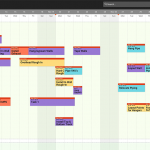Welcome to the third installment of Touchplan’s ConTech series. In this piece, MOCA’s Software Products Division President Michael Carr delves into the subject of data and shares his advice on five ways to stay ahead of the data disruption brewing in the construction industry.
If you aren’t convinced that data is disrupting the world, consider this. According to Synergy Research Group, capital expenditure by the world’s largest cloud, SaaS, social network, and tech companies exceeded $75 billion last year, with most of their investment going to data center infrastructure. That’s more than the GDPs of two-thirds of the countries in the world. And, over the last three years, total capital expenditure by these same companies exceeded $180 billion.
Why such heavy investment in data center infrastructure? Simply put, data is everywhere and increasing rapidly. Those who are able to capture it, assess it, discern truth from error, and use it to make informed decisions will have an unprecedented advantage over everyone else.
As business leaders in construction—or any other industry, for that matter—we are often called to make critical decisions based on limited supporting data. While it is sometimes a part of the job and always will be to some extent, things are changing and leaders lacking timely, reliable and insightful data to support their decisions will soon find themselves greatly disadvantaged.
Let me illustrate. Have you heard of Waze? It’s a navigation app that gives you turn-by-turn directions to get from where you are to where you want to be, all while accounting for current traffic conditions and notifying you of road hazards, construction and police sightings along the way. All the information you need is right at your fingertips, and it’s amazingly accurate. (More on that later.)
Anyhow, a few weeks ago, I was on the highway heading home from the airport, and I was seeing traffic build up. I turned on Waze and discovered that there was a major accident ahead. Traffic was at a virtual standstill for the next four miles. Waze immediately calculated a new route. It directed me to bypass the stretch of highway ahead of the accident using secondary roads and then dropped me right back on the highway just past the accident. Probably saved me an hour. Even though I didn’t know the neighborhood, I was able to navigate around the accident like a local driver. On top of that, only a handful of other drivers knew about the shortcut too, so there was no traffic as I made the detour. It’s a simple illustration, but it highlights how data is disrupting our world, and how having it and being able to harness it is tremendously advantageous.
Now think about your own business. What decisions are you required to make today with limited or no data? How would your business change if you had new insights into these areas from reliable data? How disadvantaged would you be if your competitors had these insights and you didn’t? This is high-stakes stuff, and, as with any disruption, there will be winners and losers. The good news is that there is still time for those of us in construction to respond to our advantage.
Here are five things you should do to ensure you stay ahead of the data disruption.
1. Start Capturing More Data
It almost goes without saying that you need data if you are ever to harness it and use it to inform your decisions. Find ways to standardize your business processes and minimize the use of customized, one-off solutions and spreadsheets. Standardized business processes have a nice side effect of producing standardized and well-structured data.
Also, move from analog to digital. Notebooks, Post-Its and whiteboards are great for getting information out of people’s minds and into the open. They’re also great for sharing ideas with others and quickly recording everyone’s collective thoughts. But all of that data cannot be readily used in the digital world, and often lacks consistent structure, making it difficult to use even if someone takes the time to put it in a digital format. Look for systems that offer the benefits of analog while still being digital. Consider tablets, smart boards and software like Touchplan.
2. Make Sure It’s Good Data
We’ve all heard the saying, “Garbage in, garbage out.” All the data in the world won’t do you any good if it’s erroneous. However, there are some simple steps you can take to help ensure the data you collect is accurate.
First, automate data collection wherever possible. Waze does this quite well, automatically capturing its users’ locations, speeds and directions of travel in real time, all without requiring any kind of manual input. Although the availability and use of sensors in construction is still in its infancy, we’re seeing more and more sensor use in our daily lives. Lights controlled by motion sensors, key fobs that open doors, and the RFIDs used in highway tolls are a few examples—to say nothing of our smartphones with GPS tracking, fingerprint security and now even facial recognition. It’s only a matter of time before these technologies spread to construction.
Second, if you need people to report out the data, get it straight from the source. Don’t collect it and make it someone’s job to enter it into some system on behalf of others. It makes for a lot of unnecessary work. Also, doing so opens up the possibility of introducing transfer and interpretation errors and it reduces people’s level of concern in the accuracy of their data because they feel disconnected from it and not personally responsible. Drivers with Waze directly report when they see accidents, road hazards or police activity, and it all happens in real time without any intermediate step.
Third, enable community validation if you can. The more eyeballs that see your bits of data, the more likely errors are to be caught and fixed. Waze does this by asking drivers approaching a reported traffic issue to “Thank” the person who made the initial report if they see the issue too. Often, simply exposing the results of everyone’s data reporting to the rest of the team is sufficient to flag errors and get them corrected.
Finally, make sure the people reporting data derive a benefit from reporting it accurately, ideally by making their jobs easier. Use the data to eliminate steps they would otherwise have to perform, or give them some new insight that can inform their decisions. For example, if you’re looking to capture installed materials by day, give your foreman a system to plan out their material requirements by area and then use that data to automatically order their materials for them. Later, when they update their daily progress by area, you’ll have the material quantities by day information you’re looking for and you’ll have streamlined the process they need to go through for ordering their materials. Everybody wins.
3. Make Your Data Accessible
Having lots of good data doesn’t get you very far if it’s all stored on different devices or in different applications. You need to get to it to use it. There are a couple of strategies here that you’ll want to consider.
First, look at storing your data in the cloud. It makes your data readily accessible to you and those with whom you want to share it. It also provides you with commercial-grade server redundancy, data backups and security often lacking with private hosting.
Second, seek out software applications able to integrate and share data with other applications. Software integrations in construction are relatively new, so don’t be surprised if your favorite “best-in-breed” application is still developing them. But do make sure that it factors high on their development roadmap. No one wants to go back to the days when your only option for sharing data across applications was either by piecing something together yourself (any MS Access or Excel wizards out there?) or purchasing inflexible, all-in-one applications with modules that fall short of other options on the market.
4. Invest in Data Visualization
You need a dashboard, maybe even a few if your data is hard to consolidate. Dashboards enable you to see your data through different lenses and from different angles and vantage points. Without dashboards, it’s difficult to make sense of your data and draw any real conclusions from it.
As with the dashboard in an airplane or your car, business dashboards need to present you with information that’s clear, concise and actionable. Here are eight things to look for in a dashboard:
- Fresh, actionable data. Data latency should match or better your decision cycle.
- Dynamic data that reflects the current state and shows how is it changing.
- Carefully selected metrics that reveal and magnify issues so that you can quickly know what to focus on.
- Comprehensive coverage without any blind spots.
- Interactive filtering and drill-down capability so you can zero in on areas of interest and understand driving factors.
- Intuitive presentation so that you understand at a glance the information being conveyed.
- Shareable information that your entire team can distribute and use when needed.
- Timely alerts that can be set to prompt your team when the data shows something that you’ve indicated is important.
5. Start Developing a Culture That Values Data
It’s important to instill an appetite for data in your organization so that people are encouraged to continually look for new sources of data and ways to apply it. A data-driven culture seeks out ways of using data to inform decisions, highlights good results, defines success metrics and starts measuring them to gauge performance.
When people directly benefit from providing accurate data, more care is taken to ensure that the data is good. With higher-quality data and more organizational emphasis on its value, your team will be able to make better, more informed decisions. As your team sees the benefits of the data they collect, they’ll become increasingly invested in its accuracy, analysis and ongoing development.
About MOCA Software Products
Our mission is to fill the technology gap in construction by creating specialized tools that everyone can use to improve efficiency. Our flagship product, Touchplan®, is the only real-time collaborative planning tool designed specifically for construction teams to measure, validate and continuously improve the building process, enabling our customers to win more projects and grow profits while improving their reputation in the industry as a builder, employer and partner.
We’re working hard to ensure that our customers are prepared for the changes and opportunities that data disruption is bringing to our industry. All five factors mentioned in this article weigh heavily on what we do. We’re currently developing dashboards designed to provide our customers with accurate, real-time visibility into their business based on their team’s activity in Touchplan. We’re also working to make it even easier for our customers to capture more of their data with an enhanced user interface and new user-defined data fields, all with an eye to capturing and using accurate actual production data to inform and improve the planning and execution of projects.
Want to learn more? Register here for Touchplan’s webinar, “How to Earn a Better Reputation in the Construction Industry as a Builder, Employer, and Partner” at the upcoming Lean Construction Institute Congress.










